CSS Forums
Monday, April 29, 2024
03:55 AM (GMT +5)
03:55 AM (GMT +5)
|
|||||||
 |
Share Thread:
 Facebook
Facebook
 Twitter
Twitter
 Google+
Google+
|
|
|
LinkBack | Thread Tools | Search this Thread |
|
#1
|
||||
|
||||
|
Inside APS A look back at how events unfolded on that fateful day The untold story of SSG operation at APS 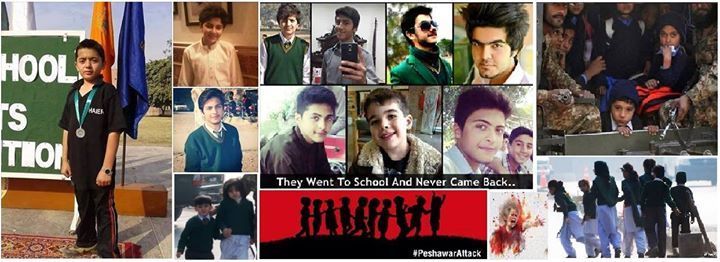 It’s a bright, sunny, winter morning. The mist has cleared and everything is alive with the warmth of the sun after a long, freezing night. But a chill still lingers in the air. Something is amiss. The air is heavy with an eerie sense of foreboding. At the Ghazi Base, the headquarters of the Pakistan Army’s elite Special Services Group, commandos are competing for the title of best marksman. A message is radioed for Zarrar Company, which specialises in anti-terrorist and heliborne operations. There is a situation in Peshawar. And they have to fly. At once. No time for procedures. No mission brief, no recon, nothing. Just pack up and fly. Normally, the SSG needs at least one-and-a-half hour to prepare for a mission. But today, they are battle-ready within 20 minutes and board the helicopters. They are going for a mission that will turn out to be arguably the toughest of their lives. Never before in the history of the SSG has an assault team readied for a mission at such short notice. The commandos still don’t know what awaits them in Peshawar as five Mi17 helicopters carrying them lift off. En route they are informed about the mission: terrorists have attacked the Army Public School. Nearly a thousand students are registered in the military-run institute and a massacre is feared. Nearly 40 minutes later, the Mi17s land at Peshawar’s Army Stadium and the commandos are driven straight to the scene of action. Outside the school, it is sheer chaos, utter panic. Wailing ambulances ferry the casualties; military men rush rescued schoolchildren to safety; distraught parents frantically search for their children, jostling to break the security cordon. Sporadically, gunshots ring out inside and small explosions go off. It’s a race against the clock. Every moment is precious. Every second can mean life — or death. This isn’t a hostage situation; the terrorists are methodically killing everyone, not even sparing those as young as five. After a quick, short briefing, the operation commander decides to launch the first assault team. “Who will volunteer?” the commander asks. Everyone steps forward. The first assault team is quickly assembled. There is no time for contemplative strategy. As a commando who took part in the assault would later say, “It was one of the toughest operations for us in many ways.” They would have to fall back on their core instincts, honed by specialized training. Four commandos go inside and cordon off the nursery section. Dozens of toddlers are rescued. As they move to secure other classrooms, a piece of glass cracks under the boots of one commando. Three terrorists inside a classroom are alerted. They fire a barrage of gunshots. A hand grenade follows. The grenade lands hardly five meters away from the commandos. Luckily, it doesn’t go off. As the commandos take cover, another grenade is hurled. It explodes around 15 meters from them. Some sustain shrapnel wounds. They do not fire back, fearing there will be children inside. “There was little time for calculating our moves,” the commando would later reflect. “Whatever had to be done had to be done quickly”. The terrorists were rampaging through the compound and killing whoever they found. We could not fire back at the terrorists freely because we wanted to ensure no child was hit by our bullets.” A second assault team springs into action. And they barge straight into the room from where they received fire. It is a stun action. The terrorists loaded with AK-47 assault rifles, hand grenades and suicide vests fire a hail of gunshots – but miss. In a lightening reflex-action the commandos strike back. Two terrorists lie dead on the ground, a third is hit and the explosives strapped to his body goes off – perhaps by the impact of the bullets. “In hostage situations, a counter assault is meticulously planned and carefully executed,” another commando would later state. “But we didn’t have much time for planning as the terrorists were on a killing spree. They did not plan on taking hostages.” Hearing the explosion, a fourth terrorist runs towards the classroom. He blows himself up on the veranda. “He was looking skyward and his back was towards the assault team. One commando was hit by shrapnel and martyred,” the commando would later recall. It is the first, and turns out to be the only, fatality Zarrar Company sustained in the entire operation. Two more terrorists emerge from another block. They fire at the commandos but a third assault team covering them engage and takes them down before they detonate the explosives strapped to their bodies. As the commandoes move forward, they hear screams and cries of children from a classroom. Going in from the main door can be risky. They break the exhaust fan of the classroom and get inside with the help of a scaling ladder. Dozens of children are rescued. 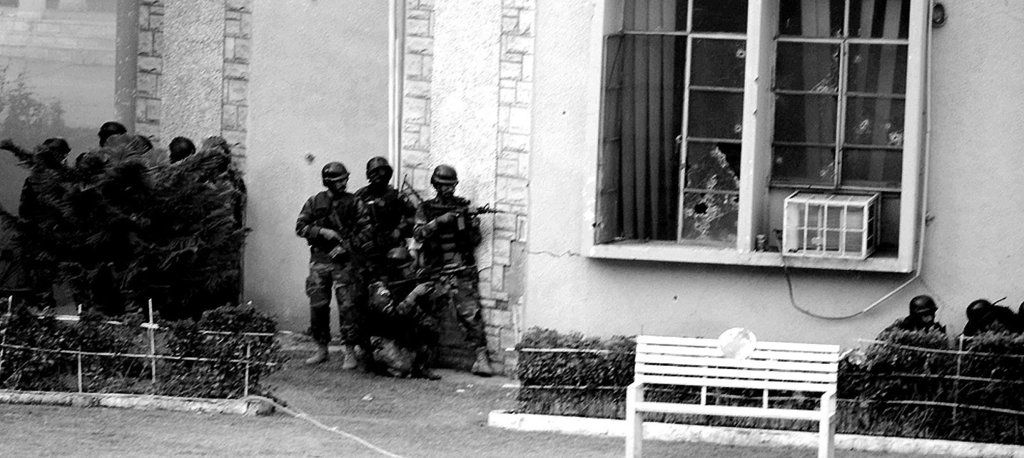 The assault teams are unsure how many more attackers are still on the loose in the sprawling compound. The sun is setting. Concerns for the safety of survivors grow. The terrorists can take advantage of darkness and kill more. Looking back, the commando would highlight this disparity of information. “We had little information about the building, like the number of rooms, where they were located, and so on. The terrorists, on the other hand, had done proper recce before the attack.” A fourth assault team is launched. And they all begin stacking, a term used in the military for cordoning off areas to restrict the enemy’s movement. They move block to block to secure the areas and deny the terrorists ease of movement. Two terrorists have moved to the administration block. The commandos pin them down in the Principal’s office. One is shot dead, but the second triggers the charge. The body of the Principal, Tahira Qazi, would later be found in the bushes outside her office with a single shot to the front of her head. The body is believed to have been thrown out of the office by the impact of the suicide blast. The combat has now lasted nearly four hours. Hundreds of pupils have been rescued. But the SSG teams want to comb the entire premises to make sure all the terrorists have been sent to hell. It takes them a few more hours to declare the premises clear for a subsequent sweeping operation. There are fears that the terrorists might have rigged the building with improvised explosive devices. While the clearance operation is ongoing, information is radioed to the commandoes about more than a dozen staff hiding in a washroom. Throughout the bloody rampage they have been in contact with military officials outside the school and told them about their whereabouts and asked for help. In the end, they are rescued by the commandos. Nine hours after the cataclysmic siege began the military secures the entire compound. The scenes are unspeakable. The air is filled with fresh gunpowder and smoke. Almost every wall is pockmarked with bullets or torn off by explosives. The blackened rooms, the lawns and the verandas are scattered with the dead and the injured. Most of the casualties happened before the SSG commandos mounted the assault. After sneaking into the school, the terrorists, donning military fatigues, went straight for the auditorium where a first aid training session was in progress. It was here the bulk of the carnage played out. Nearly 100 people, mostly students, were massacred. Those who found ways to escape were chased and hunted down on the lawns and on the veranda. However, the quick action of the SSG commandos saved hundreds of lives because the terrorists planned to hold off for as long as they could and spill as much blood as they could. Piles of bullet-riddled bodies of children. Blood-stained uniforms and books. Agonizing screams and moans of the injured youth. Frantic cries for help. Pure, primal desperation. These scenes were enough to shatter the composure of SSG commandos who have through their careers seen blood and gore in all its varieties. “When I came back home and met my children,” says another commando now, almost a year on from the attack, “I thought of the parents who lost theirs in the APS attack and I choked on tears. Only a parent can feel the pain of losing a child.” 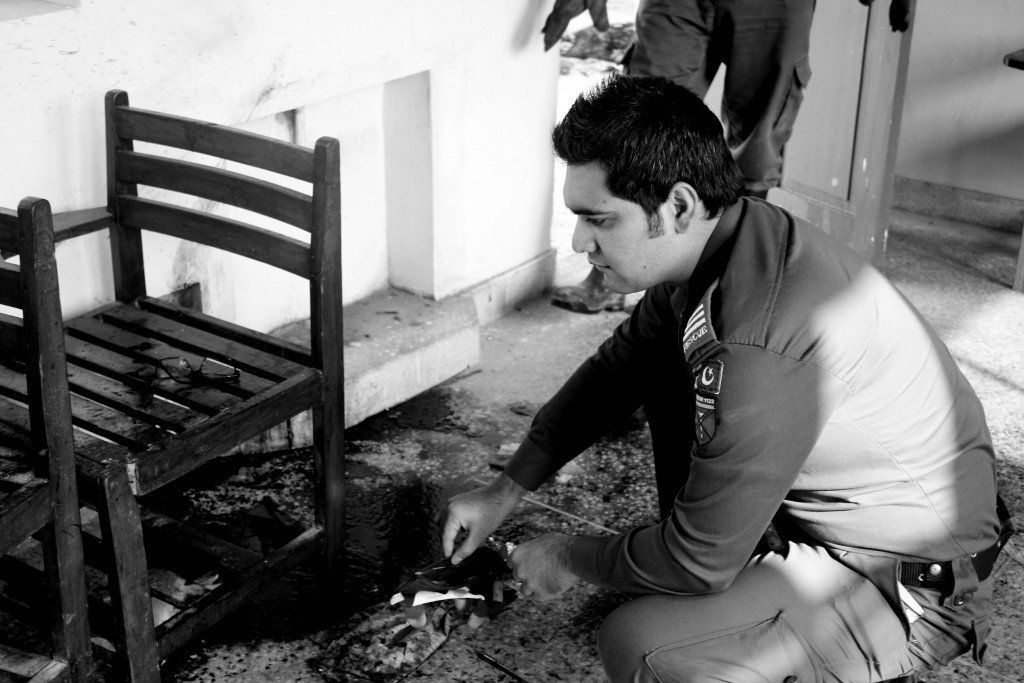 Seven hours of terror in Peshawar 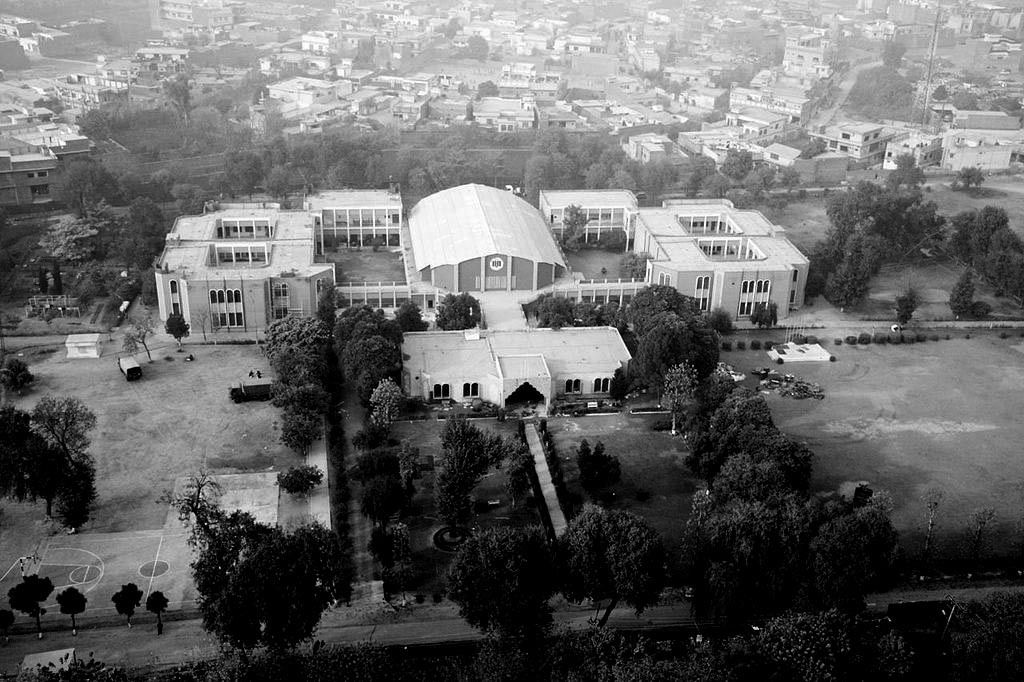 Nine minutes after the first call from Army Public School Principal Tahira Qazi, who reported the incident as per existing standard operating procedure, the damage had been done. By the time calls were intercepted, one of the attackers was telling his handler in Afghanistan, “We have killed 350 of them.” Later the toll was confirmed at 147. Six minutes before that, a daily army briefing was interrupted again and informed the Quick Response Force (QRF) — which had been dispatched and would reach in three minutes — would not be enough. At the CCPO around the same time: “There is firing going on in the area near APS,” an army officer told the capital police around 10am. This message was relayed to the then SSP who called the 2nd Brigade. A colonel confirmed only that firing had been heard. He asked for the police Rapid Response Force (RRF) strike force. According to a senior police official still in service, after the CCPO consulted with the colonel, the RRF was also dispatched. Till then the intercepts had not come in and the APS siege was being treated as a hostage situation. It was only when surveillance vehicles picked up on chatter when the real intention of the attackers suddenly became crystal clear. Well into the action, more communication was intercepted: “The target here is better”, reflecting the terrorists were moving towards the younger students. That was then when the Special Services Group (SSG) or special ops — who were awaiting confirmation—jumped in. The school was breached and the operation began. The orders were clear: “Not a single child should be hurt”. December 16 was one of the most challenging days faced by the armed forces and law-enforcement – it was not a situation that could be suppressed by brute force. It required a precision strike which selectively eliminated the terrorists (which were an unknown number) amid 1,880 innocents, according to the school register. No one could storm the school. 9:20am inside the school Around 9:20am, students were collecting into the auditorium for a first aid drill. “It was third period, we had just started reading the [Urdu] book when the section head knocked on the classroom door and asked us all to move to the auditorium where there was a first-aid training by CMH doctors,” according to ninth grader Sheheryar Zafar. Muneeb Dawar, a college freshman and head boy (proctor) told The Express Tribune he was standing at the front of the auditorium, directing the boys pouring in to fill the front seats. “The doors of the hall were closed by the head boy that day,” said Mubeen, another student. “I was among the proctors, the head boy gestured to me to come in the centre rows and tell students to make space and be attentive.” It took 15 minutes to set the projectors and start the seminar and after 10 minutes, the firing started. They all heard it but didn’t think much of it. Sheheryar thought it was just a drill. When the gunshots moved closer, the teachers locked the doors and the trainers told the students not to be scared. But then the attackers banged the auditorium door, not once but thrice, breaking down the door the third time, entering under the cover of a hail of bullets. That terrifying second, the principal was on the stage and the doctor was delivering the lecture, Muneeb froze in the front and Sheheryar hit the ground to hide. Students panicked. That was when Principal Tahira Qazi left to make the call which set things in motion outside. A month later, her son Ahmad Qazi said she was so focused on her students, she did not call the family but went back in even though she could have saved herself when the two security forces personnel giving the first aid training did. One of them, a major, was court martialled later for leaving the hall. Time, unfortunately, did not freeze at 10:30am. It was hours of rampage by the armed men in boots. The boots which still raise spectres of terror in children who, face pressed to ground, tie in the mouth to muffle their screams, remember the black boots walk close to bodies to kick them to separate the living from the dead, to shoot the living dead. 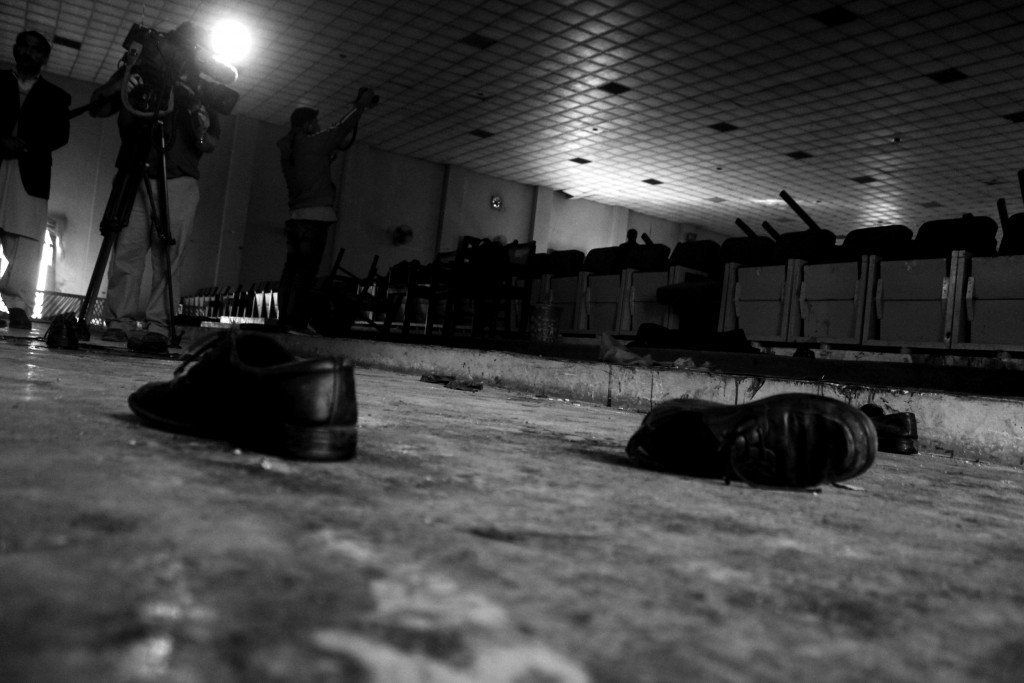 According to a then high-ranking home department official, the terrorists were following instructions of their handlers, calls tapped into by military intelligence during live action. Instructions which amounted to kill all those who are adult (“naaf peh baal, baloghat kee nishani”), attackers were told to kill those who were adults, said the home department official. And so, inside the auditorium, bodies were piling up; bodies which saved the living hiding under the cover of death. Outside, a militant on the roof was taking out students running out of the hall. Mubeen said he saw his class fellows crumple under the bullets from the sniper’s gun. “I moved from the auditorium to the administration block to find our teachers but things were worse there – nearly all of them were shot, either dead or very injured,” said Mubeen. Some said burned. By then, students who had survived the auditorium were trying to get the main entrance and the attackers were looking for more ‘targets’. Mubeen and Muneeb locked themselves in a toilet in the administration where they were found and rescued by the army around 5pm. Students in classes adjacent to the auditorium were trying hide under tables. According to Zalik*, their teacher Safia told them to lock their door but he and his mates misunderstood her and ran outside. Instead running back to class and risking getting caught by the militant sniper, the teacher told them to hide under the staircase outside. Zalik, who was in grade six, said they hid there for nearly one-and-a-half hours. By then it was almost noon. “We could hear sounds from outside and thought it was more terrorists but it was the faujis.” He said commandos helped removed the steel door going towards the toddlers section from where they were evacuated towards the Defence Park side at 12pm. Eye witnesses say the militants came to the first hall around 10:30am and then returned at 12:15pm to 12:30pm to see if there were any students alive which they could finish off. In the second round, they methodically searched rooms, toilets, corridors, even behind sofas to kill everyone. While all of this was taking place inside the school, the QRF managed to reach the site with six minutes instead of the average of eight. There were two brigadier-ranking officials and the Inspector General Frontier Corps outside the school but there was little information of what was going on inside. Munnawar* whose nephew was inside says he was one of the first to arrive outside APS as his office was within running distance. From his vantage point as a worried relative, Munnawar said he overheard the RRF, saying “we will do the operation”. The police had fired at a suicide bomber who exploded, according to Munnawar. However, there are SOPs and matters of jurisdiction which need to be abided by. According to the senior-ranking policeman, the army had forbidden the RRF from entering. “We wanted to draw the attacker out but the army did not allow.” The worried uncle managed to push past a man he recalled as Brigadier Waqar. “I told him ‘My kid is inside’ and just pushed through in.” Once inside, the army men taking positions told him “na agay na peccha [jana], the terrorists do not know that you’re not one of us.” Munnawar had no time to absorb the blood and chaos inside as he moved the troops, helping rescue children. A lecturer at a college who lived nearby arrived at APS around 10:45am but was told he would be unable to go home down the road, as was a firing incident in play. “Five minutes later, the first siren blazed through the winter morning. And then they just kept on coming.” He added, “The QRF unit was trying to stop them from spreading in the college, from reaching the toddlers section.” Munnawar says he heard the first blast while he was inside the school around 11am – Mubeen puts the time at 11:30am, others heard blasts throughout the day. However by the time the SSG unit arrived from Tarbela, the QRF was helping evacuate as many children as they could, some from the Bihari Colony side, some around Defence Park. The senior police official says the operation ended by 4:40pm, the former home department office holder puts it at 3pm, but the area was not considered clear by sundown. SSGs were on neighbouring rooftops for three days. The lecturer was also in charge of security at his college. Pointing out how the terrorists kept up a fight for hours, he said, all that ammunition, the rounds, the bombs, “how could it be so well-hidden and transported about in a car [that no law-enforcement noticed].” His relative, who observed the attack from the proximity of his house, said he counted “at least 29 blasts”. A meticulously planned attack The first threat to the school came in April of 2015, it was a “generalized” threat which mentioned APS but there are a number of Army Public Schools in Khyber-Pakhtunkhwa. The threat was taken seriously, but there was nothing specific to help with precautions. After the attack on the airport in Karachi, Operation Zarb-e-Azb had begun and concentration shifted to North Waziristan and Khyber Agency. Nonetheless, threats in urbanised localities never subsided. The military, police and law-enforcement agencies continued to foil terror bids. On an average there are 19 threats reported daily in the city of Peshawar alone. Based on which intelligence-based operations (IBO) are carried out. The tactics of the militant groups kept changing. For instance, officials said about the APS attack that the suicide jacket and handlers were now brought in separately. There was an IBO carried out on the morning of December 16; ten suicide bombers were apprehended. It was thought the treat had been averted, that’s what official accounts of the incident say. Apart from the attackers killed inside the school, the six facilitators—four of whom were hanged—included a mosque imam, a clerk and a rickshaw driver who kept photographing the area around the school with an Ipad for almost 8 months when he dropped children to school. Investigators say one of the facilitators was arrested from Bahwalnagar within 24 hours of the incident. But the way the entire attack was meticulously planned showed the intent was not shock and awe but precise elimination of “the enemy”. All six facilitators, Hazrat Ali, Mujeebur Rehman , Maulvi Abdul Salam, Taj Mohammad, Sabeel and Atiqur Rehman, who were sentenced to death and a seventh, Kifayatullah, was sentenced to life in prison had never met. They worked on the same plan but none of them ever met each other in the run-up to December 16. They did not know who the others were and would be unable to recognise them. The attackers were Pakistanis and belonged from Mohmand Agency, Kohat, Peshawar and Khyber Agency. None of them were highly educated and records show they had a proclivity towards violence. While it’s now been established that the attackers had stayed the night with the imam of the mosque which was government property, the others were assigned tasks to facilitate in various ways. Locals from the areas around APS told officials they had spotted the men with masks much before the incident had taken place and noted suspicious activity but had not informed the authorities out of fear. Bihari Colony is not populated with a people who trust authorities which do not cater to even their most basic needs. Of blame and death Once the APS operation was over, there were rumours about the casualty figures—people in all echelons believed there were bodies in the hundreds evacuated from the school. Security officials say the traumatic effect of the incident impeded how people formed opinions about the incident, particularly those who lived through the attack either directly or through the trauma of a son inside. To date the list of martyrs released by the ISPR is 147 which include 122 students, 22 staff members and 3 military personnel, including Lance Naik Muhammad Iltaf who jumped in front of gunfire to save students despite orders to refrain. Tales surfaced of insiders involved in the job. The person who ran the canteen who was rumoured to have been involved in planning the attack still runs it to this date and is resident of Cherat, Nowshera district. The main perpetrators of the attack Khalif Umar Mansoor whose real name is said to be Aurangzeb and is a resident of Badabher, Peshawar and TTP chief Maulana Fazlullah have been hiding in Afghanistan, where the APS attack was planned. There have been other incidents of violence traced back to the same group in the months that have followed. As a result, from high-level officials in the home department to locals on ground, Afghan refugees have been blamed. “During 1977, Afghans arrived and the jihadis started; Peshawar felt the repercussions – in blasts,” said the home department official. “Officially, they need to be returned and they are the root of all evil, at the nexus of all gangs,” he added. Instead of letting them spread, he said, they have to be “kept in one place and all provinces have to help manage.” However, military operations have gained much ground to avert the possibility of any such incident in the future. APS shifted narratives, nationally, and now the point remains to bring the perpetrators of the attack to justice. *Names have been changed to protect identities **Based in part on eye-witness accounts Rescue workers recall ‘blood and bullets’ inside APS “The tragedy replays in front of my eyes even now; I can’t sleep well at night,” rescue worker Muhammad Khalid Khan told The Express Tribune. “I still remember the blood-soaked bodies of phul jaisay bachay (innocent kids) who were massacred for no fault of their own in cold blood by beasts.” The 25-year-old Rescue 1122 worker added he has kept his blood-stained uniform in a glass-cabinet so he always remembers the massacre that shook the whole world. Stuff of nightmares Although Muhammad Khalid spends most of his time in the office as a telephone operator, on December 16 he was also dispatched to Army Public School. The director general of Rescue 1122 had imposed an emergency and everyone was rushed to the school after receiving a call at 10:45 am. “Within ten minutes rescue workers reached the school,” said Muhammad Khalid. “All the staff, including the janitors and director general, participated in the rescue operation. We stayed till the school was completely cleared.” The rescue workers who reached the school first said they were initially held back as a fierce battle was going on inside the school. However, after some portion of APS was cleared, they were allowed to enter. “There were bullets flying above our heads; we had to crawl to reach injured children.” Upon reaching the hall, said Muhammad Khalid, they found four children injured in a corner and rescued them. He added, “I just somehow made sure that I got out of there alive.” Sheraz Ahmad, a firefighter, said he was on leave that day but after hearing about the attack, he rushed to work and found a rescue ambulance on the road. Ahmad added they were not allowed to enter the school at first; only later after some areas were cleared of militants. Marked forever Rescue workers said the floor was soaked in blood and the walls were riddled with bullets. “Blood stains were all over walls, and school bags, books and shoes of children were lying scattered everywhere,” said Muhammad Khalid. “At first it was very difficult to work inside the school as the bullets were constantly being fired and explosions could be heard.” Rescue 1122 Spokesperson Bilal Faizi, who was also part of the operation, said, “We must have heard around 30 explosions of low and high intensity after entering the school.” He added they not only rescued students but also security forces personnel who were injured in combat. Although their ambulances are equipped with all life-saving facilities, workers themselves do not have bullet-proof jackets or helmets to keep themselves safe. “The workers are trained for rescue operations but they have never worked in crossfire,” said Faizi. But workers told The Express Tribune they did what was needed because it was a question of humanity. Neglecting caregivers Rescue 1122 workers said they were in a state of shock for many days, but no counselling or psychological help was provided to any of them. They said people think whatever they did just their job, even though they only had six months of training from an academy in Lahore. “I was unable to sleep or eat for many days as the scenes from APS kept flashing before my eyes,” said Muhammad Khalid. “It was the first time I saw so many bodies,” said Ahmad. “It was terrifying and tragic at the same time; I still feel sad and can’t forget them.” He added they later took medicines to cope with stress and depression. “We were shocked to find the injured and dead scattered around,” said Ahmad. “Everybody was devastated; scores of innocent victims were rushed to the hospital.” He added they had faced a similar situation when militants attacked All Saints Church in Peshawar in 2013. Rescue 1122 DG Asad Ali Khan said, “The country has accepted our efforts and we have been facilitated by the government to expand this service to other parts of the province.” Mai Aisi Qoum Se Hoon Jis Ke Wo Bachon Se Darta Hai, Bara Dushman Bana Phirta Hai Jo Bachon Se Larta Hai! 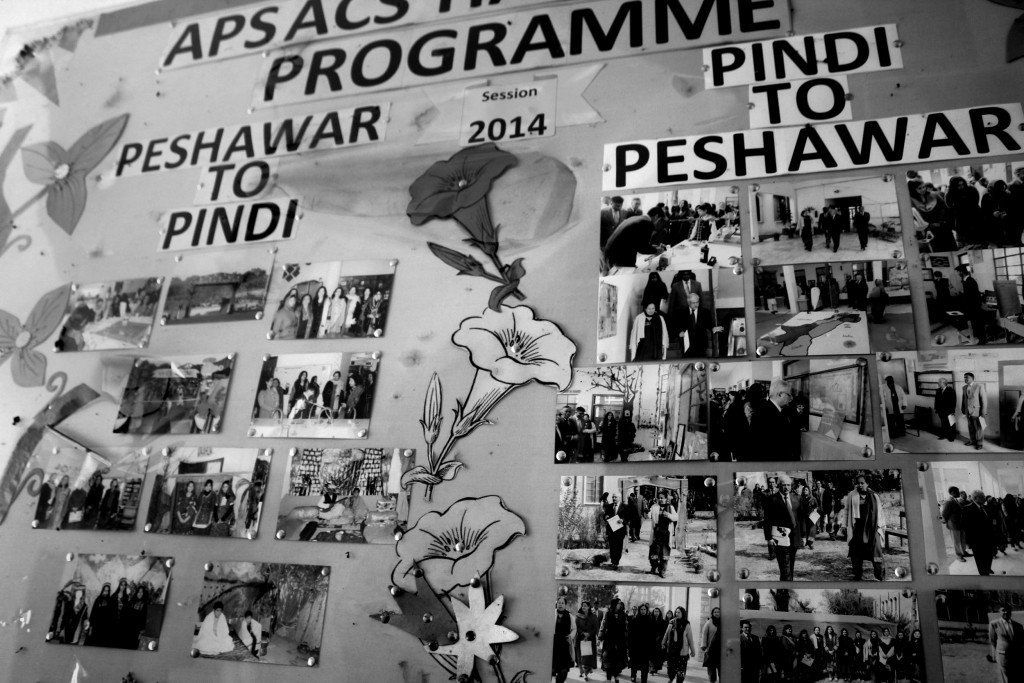 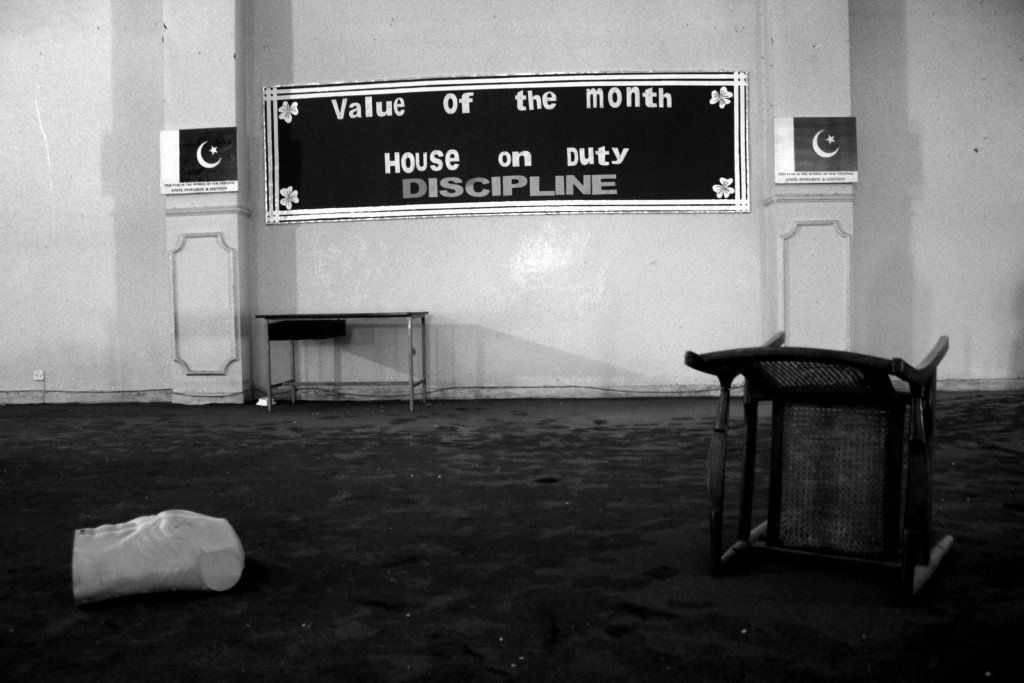 Source: Inside APS |
| The Following 4 Users Say Thank You to Man Jaanbazam For This Useful Post: | ||
Adele (Friday, December 18, 2015), sidrahhh (Friday, December 18, 2015), sincere khan (Friday, December 18, 2015), vital (Friday, December 18, 2015) | ||
|
#2
|
|||
|
|||
|
ISPR Song "Mujhay dushman Kay Bachon ko Parhana hai" brings hope that there is still an ALLAMA IQBAL in Pakistan,,it is strengthening our resolve to fight the terrorists exactly in line with with prophet's teachings.
OMG! its a prophetic notion,,hats off to the originator#ISPR |
| The Following 2 Users Say Thank You to vital For This Useful Post: | ||
Man Jaanbazam (Friday, December 18, 2015), sincere khan (Friday, December 18, 2015) | ||
 |
«
Previous Thread
|
Next Thread
»
|
|
 Similar Threads
Similar Threads
|
||||
| Thread | Thread Starter | Forum | Replies | Last Post |
| PPSC one Paper Preparation Material all in one | Monk | Past Papers | 22 | Friday, July 17, 2020 10:57 PM |
| development of pakistan press since 1947 | Janeeta | Journalism & Mass Communication | 15 | Tuesday, May 05, 2020 03:04 AM |
| Solved Everyday Science Papers | Dilrauf | General Science & Ability | 4 | Friday, April 08, 2011 06:10 PM |








